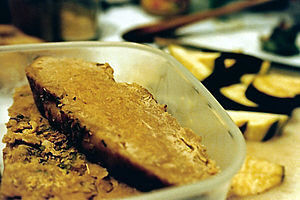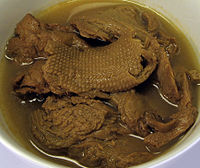Seitan

Wheat gluten, also known as seitan (SAY-tahn), wheat meat, gluten meat, or simply gluten, is a food made from the gluten of wheat. It is made by washing dough made from wheat flour in water until the starch is rinsed away, leaving only the gluten, which can then be cooked and processed in various ways.
Wheat gluten, although not as well known, is an alternative to soy-based meat substitutes such as tofu; some types may taste even more like meat than tofu due to their chewy and/or stringy texture. It is often used in place of meat in Asian, vegetarian, Buddhist, and macrobiotic cuisines.
Wheat gluten is most popular in China, where it was first developed, as well as in the cuisines of other East and Southeast Asian nations. In Asia, it is commonly found on the menus of restaurants catering primarily to Buddhist customers who do not eat meat, but who nonetheless enjoy eating meatless versions of meat dishes.
Because it was first popularized in western nations during the second half of the 20th century through its promotion by proponents of the macrobiotic diet, seitan (the name by which it is known in macrobiotic circles) is also the name by which wheat gluten is best known in most English-speaking nations. In the West, prepared wheat gluten is generally available only in Asian markets and health food stores (although gluten flour is commonly available in supermarkets).
Wheat gluten is also sometimes used in pet foods.
Forms
Chinese


Wheat gluten, called miàn jīn in Chinese (traditional: 麵筋, simplified: 面筋, literally "noodle/dough tendon"; also spelled mien chin or mien ching) originated in ancient China, as a meat substitute for adherents of Buddhism, particularly some Mahayana Buddhist monks, who are strict vegetarians (see Buddhist cuisine). There is a story which claims that the idea originated from the annual traditional week of vegetarianism observed by Chinese emperors, for which the royal chefs invented the technology (cf. Vegetarian Paradise 2 menu, New York City; Harmony Restaurant Menu, Philadelphia, etc.).[citation needed] Miàn jīn is often deep fried before being cooked in Chinese cuisine, which confers a crispy rind that enhances the texture of the gluten.
There are three primary Chinese forms of wheat gluten:
- Oily/oil fried gluten (油麵筋, yóu miàn jīn): Raw gluten that has been torn into small bits, then deep fried into small puffy balls of around 3–5 cm in diameter and sold as "imitation abalone". They are golden brown in color, and braised or boiled in a savory soup or stew before eating. They are frequently paired with xiang gu (black mushrooms).
- Larger fried balls of gluten (大面筋球, dà miàn jīn qiú) up to 5 inches in diameter are sometimes seen in Asian supermarkets. These are often stuffed with meat or tofu mixtures and served as a dish called "gluten meatballs" (面筋肉圆, Miàn jīn roù yuán) or "gluten stuffed with meat" (面筋塞肉, miàn jīn saī roù).
- Steamed gluten (蒸麵筋, zhēng miàn jīn): Raw gluten that has been wrapped around itself to form a long sausage shape which is then steamed. This type of gluten has a dense texture and ranges from off-white to light greenish grey in color. It is torn open into strips before being used as an ingredient in recipes. Larger blocks of steamed gluten may also be colored pink and sold as vegetarian "mock ham."
- Baked spongy gluten (traditional: 烤麩; simplified: 烤麸; pinyin: kǎo fū): Similar in texture to a sponge, kao fu (sometimes labeled in English as "bran puff") is made by leavening raw gluten, then baking or steaming it. These are sold as small blocks in Chinese markets and are then diced up and cooked. This type of gluten absorbs its cooking liquid like a sponge and is enjoyed for its "juicy" character. Chinese kao fu is coarser in texture than its Japanese counterpart, yaki-fu, due to the relatively larger air bubbles it contains. Kao fu is available in fresh, frozen, and canned forms.
Miàn jīn is also available in Asian grocery stores in canned and jarred forms, often marinated in combination with peanuts or mushrooms. Such canned and jarred gluten is commonly eaten as an accompaniment to congee (boiled rice porridge) as part of a traditional Chinese breakfast.
Freshly prepared miàn jīn can be difficult to find in Chinese restaurants other than those specializing in Buddhist or vegetarian cuisine. Depending on its method of preparation and ingredients used, both fresh and preserved miàn jīn can be used to simulate pork, poultry, beef, or even seafood.
Japanese
In Japanese cuisine, the traditional type of wheat gluten is called fu (麩, lit. "gluten").
There are two main forms of fu, the raw nama-fu, and the dry yaki-fu:
- Raw (nama-fu 生麸): Solid gluten is mixed with glutinous rice flour and millet and steamed in large blocks. It may be shaped and colored in a variety of ways, using ingredients such as mugwort. Popular shapes include autumn-colored maple leaves, bunnies, and other generally "cute" forms. Such shapes and colors enhance the attractiveness of the cooked product since steamed gluten has an unappealing grey tone. Nama-fu is an important ingredient in Shōjin-ryōri, the Buddhist vegetarian cuisine of Japan. It may also be used as an ingredient in wagashi, Japanese confectionery.
- Fu-manjū (麸まんじゅう) is a type of manju made from nama-fu. Solid gluten is sweetened and filled with various sweet fillings such as red bean paste. They are then wrapped in leaves and steamed in a manner similar to that used to prepare Chinese zongzi.
- Dry baked (yaki-fu 焼き麩 or sukiyaki-fu): The gluten is leavened with baking powder and baked into long breadlike sticks. It is often sold in cut form, as hard dry discs resembling croutons or bread rusk. Yaki-fu is typically added to miso soup and sukiyaki, where it absorbs some of the broth and acquires a fine texture that is lighter and fluffier than its Chinese equivalent. It is the most commonly available type of fu in Japanese supermarkets.
In Japan, seasoned "gluten meat" (i.e. seitan, as cooked in the macrobiotic manner), is not well known or widely available, despite the macrobiotic diet's Japanese origins. When used, the terms for this food are rendered in katakana as グルテンミート (Romanized "gurutenmiito," from the English "gluten meat"), or, rarely, セイタン ("seitan"). Outside macrobiotic circles, these terms are virtually unknown in Japan, and they do not typically appear in Japanese dictionaries.
Vietnamese
In Vietnam, wheat gluten is called mì căng or mì căn, and is prepared in a similar fashion to Chinese miàn jīn. Along with tofu, it is a part of the Buddhist cuisine of Vietnam, which is strongly influenced by that of China.
Macrobiotic
Seitan, a neologism of Japanese origin, is the name used to refer to wheat gluten in the macrobiotic system of cooking and health, as formulated by the Japanese-born philosopher George Ohsawa (1893–1966). According to the Oxford English Dictionary, it is said to have been coined by Ohsawa in the early 1960s, but its etymology is uncertain, with the most likely explanation being that it is derived from the Japanese sei- ("to be", "to become"), or -sei ("of the nature of," "made of," e.g. in shokubutsu-sei, "made of vegetable") + tan-, as in tanpaku(shitsu) ("protein").
As prepared in macrobiotic practice, seitan consists of powdered wheat gluten, which is extracted from whole wheat flour by washing the flour and rinsing away the starch. The gluten powder (also called vital wheat gluten or gluten flour) is then mixed with just enough water to form a stiff paste, which is then kneaded in order to produce a firm, stringy texture. The dough is then cut into pieces and cooked via steaming, boiling, frying, or other methods. While seitan is itself rather flavorless, it holds a marinade very well and is usually simmered in a dashi (broth) made from soy sauce, kombu, ginger, and sometimes also sesame oil.
Western
Since the mid-20th century, wheat gluten (generally known by its macrobiotic name, seitan) has been increasingly adopted by vegetarians in western nations as a realistic meat substitute, particularly by vegetarians who previously ate meat and miss its taste and/or texture.
It is sold in block, strip and shaped forms in North America, where it is very difficult to find outside of Asian food markets, health food stores and cooperatives. Some companies also sell powdered gluten (marketed under the names "vital wheat gluten" or "gluten flour"), for those who wish to make their own gluten from scratch. Wheat gluten is also used by bakers to increase the chewyness of breads. The block form is most prevalent and is often flavored with shiitake or portabello mushrooms, fresh cilantro or onion, or barbecue sauce, or packed in a vegetable-based broth. In strip form, it is usually packed to be eaten right out of the package as a high-protein snack. Shaped seitan products, in the form of "ribs" and patties, are usually flavored with barbecue, teriyaki or other savory sauces.
In North America, there is an imitation turkey (called "Tofurky") made of seitan which is marketed around the Thanksgiving holiday, providing an alternative for vegetarians who choose not to eat the traditional holiday centerpiece. Wheat gluten is also used by The African Hebrew Israelites of Jerusalem, a vegan African American religious sect which operates a chain of restaurants called Soul Vegetarian, to produce a vegetarian sandwich called the Garvey Burger.
Notes
See also
- Buddhist cuisine
- Coeliac disease
- Gluten
- Meat analogue
- Mock duck, another variety of wheat gluten
- Textured vegetable protein
- Tofu
- Vegetarian cuisine
- Wheat
External links
- How to Make Seitan: Illustrated Step-by-step
- Explanation of fu (Japanese wheat gluten)
- More about Seitan and Seitan Recipes
- Seitan recipes
- Wheat gluten page from Ellen's Kitchen site
- A famous Japanese fu store specializing in flavoured steamed fu and decorative fu.
- Another famous Japanese fu store specializing in dry baked fu.
- Wikiveg: Seitan
- "Un-American Pet Food: Why do we put Chinese wheat gluten in Fido's kibble?", Michelle Tsai, Slate.com, April 2, 2007
